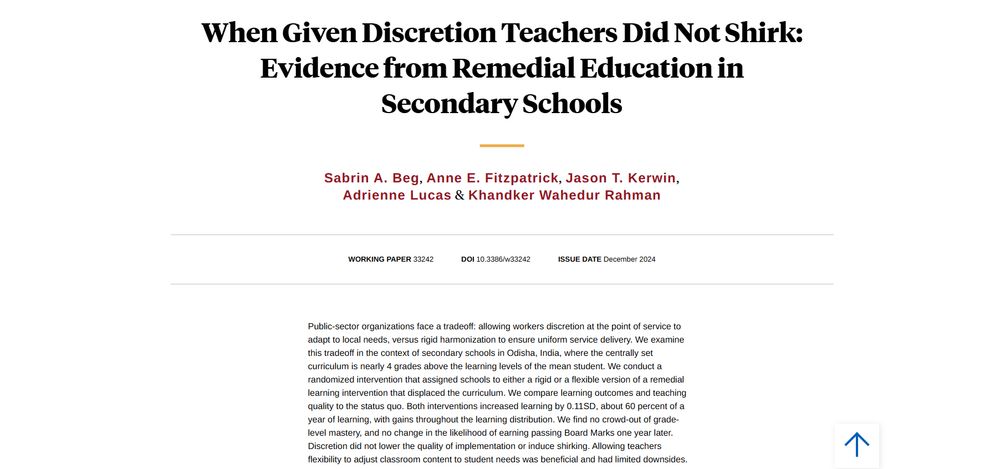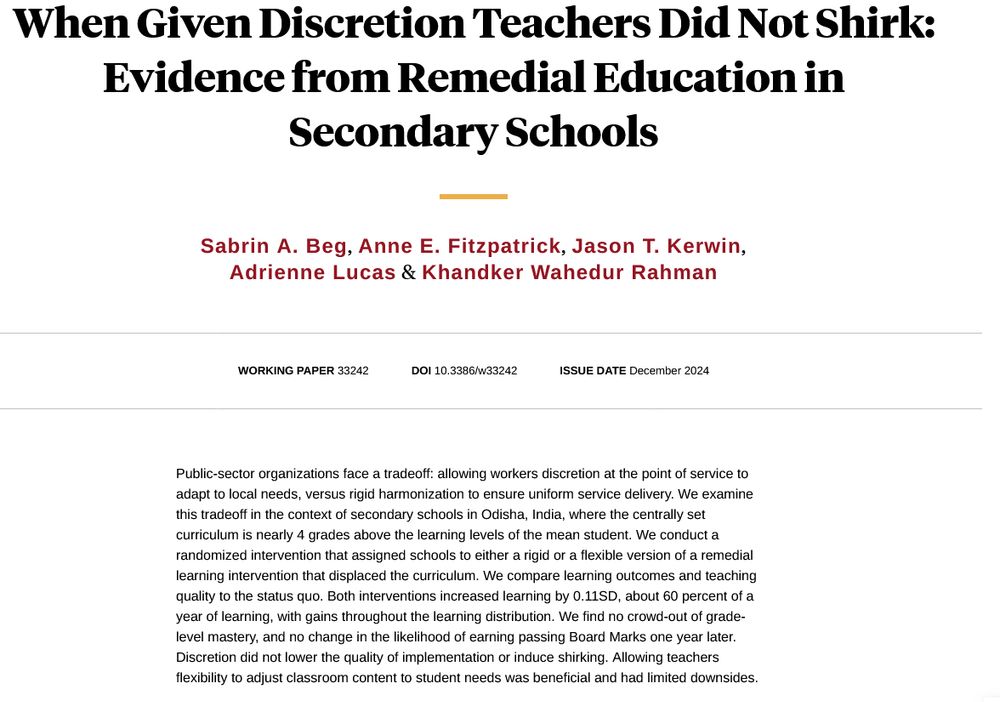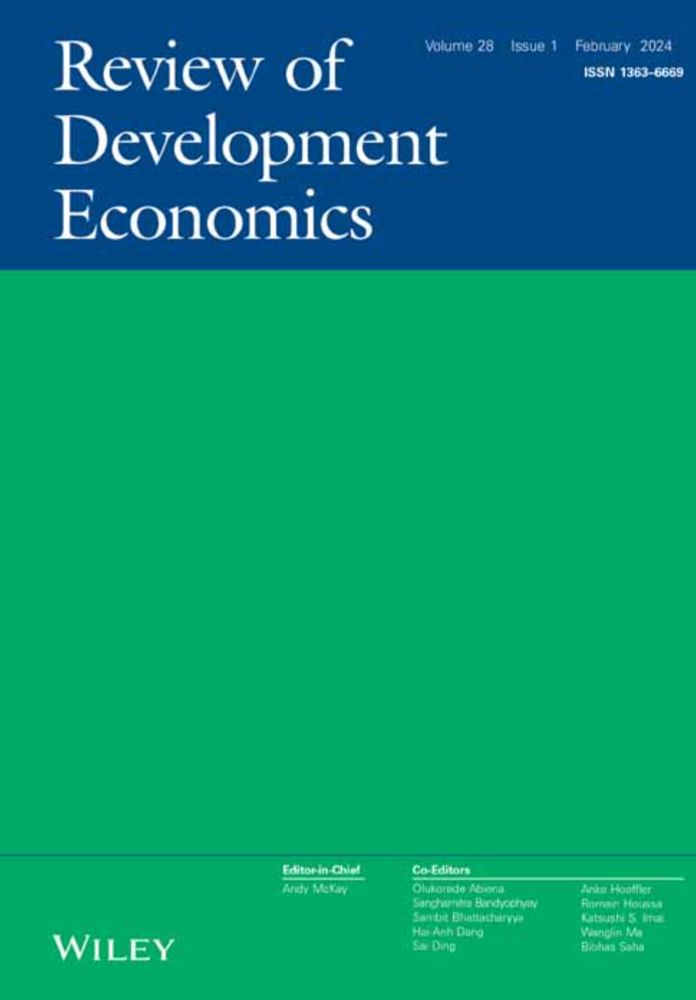I originally thought this was about econometrics.
11.04.2025 00:12 — 👍 71 🔁 6 💬 1 📌 1

A remedial education program in India worked well when teachers were given strict implementation guidelines. It worked just as well when teachers had discretion to adapt. www.nber.org/papers/w33242 by Beg, @annefitz13.bsky.social, @jkerwin.bsky.social, @profalucas.bsky.social, & @kwrahman.com
09.04.2025 10:10 — 👍 23 🔁 12 💬 1 📌 0

Screen shot of title page from NBER website.
When Given Discretion Teachers Did Not Shirk: Evidence from Remedial Education in Secondary Schools
Sabrin A. Beg, Anne E. Fitzpatrick, Jason T. Kerwin, Adrienne Lucas & Khandker Wahedur Rahman
Working Paper 33242
DOI 10.3386/w33242
Issue Date December 2024
Public-sector organizations face a tradeoff: allowing workers discretion at the point of service to adapt to local needs, versus rigid harmonization to ensure uniform service delivery. We examine this tradeoff in the context of secondary schools in Odisha, India, where the centrally set curriculum is nearly 4 grades above the learning levels of the mean student. We conduct a randomized intervention that assigned schools to either a rigid or a flexible version of a remedial learning intervention that displaced the curriculum. We compare learning outcomes and teaching quality to the status quo. Both interventions increased learning by 0.11SD, about 60 percent of a year of learning, with gains throughout the learning distribution. We find no crowd-out of grade-level mastery, and no change in the likelihood of earning passing Board Marks one year later. Discretion did not lower the quality of implementation or induce shirking. Allowing teachers flexibility to adjust classroom content to student needs was beneficial and had limited downsides.
New @nberpubs.bsky.social working paper: "When Given Discretion Teachers Did Not Shirk: Evidence from Remedial Education in Secondary Schools" with #SabrinBeg @annefitz13.bsky.social @jkerwin.bsky.social @kwrahman.com
Title summarizes it. We elaborate in the paper: www.nber.org/papers/w33242
17.12.2024 18:57 — 👍 26 🔁 7 💬 1 📌 0
A few weeks ago, I spoke on a panel about publishing at the CSWEP’s CeMENT workshop. I wanted to briefly share some of that advice here.
16.07.2024 19:32 — 👍 116 🔁 59 💬 1 📌 11
#EconSky
23.09.2024 10:32 — 👍 5 🔁 1 💬 0 📌 0
+1 please. Thanks.
21.09.2024 14:55 — 👍 1 🔁 1 💬 0 📌 0
Hope you read, share, cite. Here is the open-access link to the paper: doi.org/10.1016/j.ec... (14/14)
06.04.2024 19:12 — 👍 0 🔁 0 💬 0 📌 0
We thank handling editor Audra Bowlus, anonymous referees, and colleagues whose constructive comments helped us improve the paper. We also thank my excellent research associates Raied Arman & Farhana Kabir. (13/14)
06.04.2024 19:11 — 👍 0 🔁 0 💬 1 📌 0
We are also grateful to the WEE-DiFine initiative of BIGD. This project was a derivative of a separate project funded by them. (Check out ongoing RFPs of WEE-DiFine and WEE-Connect: bigd.bracu.ac.bd/all-projects/) (12/14)
06.04.2024 19:11 — 👍 0 🔁 0 💬 1 📌 0
Regression or population parameter estimates without accounting for statement framing might be biased and the researcher will have no way of addressing this bias. Randomizing statement framing allows credible estimation of bounds (a la partial identification). (11/14)
06.04.2024 19:10 — 👍 0 🔁 0 💬 1 📌 0

Researchers can also estimate population parameters as bounds. They can report the mean value of each statement by different framing and report the bound on the value of the parameter. (10/14)
06.04.2024 19:10 — 👍 0 🔁 0 💬 1 📌 0
Researchers can control statement framing in regression. Interaction with covariates allows obtaining two estimates of the relationship between a variable of interest and an attitude measure. These two estimates can be used as bounds on the correlation of interest. (9/14)
06.04.2024 19:10 — 👍 0 🔁 0 💬 1 📌 0
If all respondents receive the same framing, framing effects become a systematic feature of the data and cannot be accounted for in any analysis. To limit this systematic bias, we propose that future surveys randomize the framing of statements across respondents. (8/14)
06.04.2024 19:09 — 👍 1 🔁 0 💬 1 📌 0

We show that the conditional mean of each aggregated index for HH heads is significantly different between treatment and control groups. For PCA, not only does the magnitude vary, but also the sign switches. We find similar results using education status as a covariate. (7/14)
06.04.2024 19:09 — 👍 0 🔁 0 💬 1 📌 0
Building on Dunsch et al. (2018), we demonstrate the possible consequences of framing effects using two commonly used standard techniques of aggregating multiple responses: (i) Kling index (ii) PCA. (6/14)
06.04.2024 19:09 — 👍 0 🔁 0 💬 1 📌 0


Like Dunch et al (2018), we find a significant framing effect: responses vary |7| to |21| pp for the same statements between different framings. Framing effects persist among both positively and negatively framed questions. (5/14)
06.04.2024 19:09 — 👍 0 🔁 0 💬 1 📌 0

We randomly ask one of the two versions of the module: in one version, the first three statements are positively framed, and the following three are negatively framed, and vice versa in the second version. (4/14)
06.04.2024 19:08 — 👍 0 🔁 0 💬 1 📌 0
We build on this work and show that even with mixing the framing of statements there remains a significant framing effect. In a baseline survey of a study on mobile money, we ask respondents six statements to measure their attitudes towards mobile money. (3/14)
06.04.2024 19:08 — 👍 0 🔁 0 💬 1 📌 0
Asking “Is X easy to use” and “Is X not difficult to use” do not yield symmetric results. Dunch et al (2018) show that framing affects responses and suggest mitigating what they call “acquiescence bias” by mixing statement framing. (2/14)
06.04.2024 19:08 — 👍 0 🔁 0 💬 1 📌 0

🚨 New Publication 🚨
Happy to announce that @jeffbloem.bsky.social and my paper, “What I say depends on how you ask: Experimental evidence of the effect of framing on the measurement of attitudes” is published in Economics Letters.
Does framing matter when measuring attitudes?
Yes.
🧵 (1/14)
06.04.2024 19:08 — 👍 6 🔁 2 💬 1 📌 0

Save Farhan, a 29-Year-Old Battling Stage 4 Cancer, organized by SIFAT AHMED KHAN
Farhan Bin Liaquat, at the age of 29, stands as a beacon of hope a… SIFAT AHMED KHAN needs your support for Save Farhan, a 29-Year-Old Battling Stage 4 Cancer
Farhan is a dear junior from my school and college (i.e., high school). Farhan is battling vicious stage 4 stomach cancer (adenocarcinoma) and requires financial support for treatment. Kindly requesting to donate whatever you can afford 🙏
gofund.me/fdb346db
25.03.2024 16:12 — 👍 2 🔁 0 💬 0 📌 0
🚨🚨This is now available online. 👇👇 #EconSky 📉📈
authors.elsevier.com/c/1hy1X15DRG...
01.11.2023 18:32 — 👍 14 🔁 3 💬 0 📌 0

Hawthorne effects
www.thefarside.com/2023/10/24/3
24.10.2023 12:30 — 👍 5 🔁 1 💬 0 📌 0
Econometric Thread (#EconSky): Today, I will briefly discuss a few recent papers expanding the synthetic control method (SCM). I will talk about three WPss: Abadie + L'Hour (2019), Grossi, Lattarulo, Mariani, Mattei + Oner (2020); Cao + Dowd (2019) and Cattaneo, Feng, Palomba +Titiunik (2023).
24.10.2023 02:28 — 👍 55 🔁 27 💬 1 📌 2
I guess I should re-post from the Bird Site "The Rules For Academic Success here":
I always get asked for advice about starting/surviving the tenure track. Here are the rules I've found useful. Thought I'd put it out there for the masses...
This list gets longer all the time
01.08.2023 18:30 — 👍 100 🔁 51 💬 5 📌 8
Just a general rule of life that I keep reminding myself 👇👇👇
20.10.2023 20:48 — 👍 0 🔁 0 💬 0 📌 0

Here are 25+ journals where economists publish review papers. bit.ly/3QfaE6m
12.10.2023 18:37 — 👍 35 🔁 12 💬 1 📌 1

Here are 50+ journals where economists publish short papers. bit.ly/36qNVfn The list includes examples and my experience with each journal.
12.10.2023 18:35 — 👍 134 🔁 60 💬 4 📌 4
Make your axis labels horizontal so people can read them. There’s no excuse anymore, it’s 2023.
03.10.2023 02:07 — 👍 16 🔁 2 💬 1 📌 0
(Behavioral) Development Economics • Experimental Economics
I am an Economist leveraging the assignment mechanism in the field to test theory and help non-profits, govts, and anyone who will listen! My goal is to (hopefully!) change the world for the better. My picture is with my oldest son!
Applied Economics PhD student at the University of Minnesota
Interdisciplinary Doctoral Fellow at UMN Life Course Center
RA at IPUMS
Labor, women+children+families, economic demography, health
Associate Professor of Population and Family Health at Columbia. Global health researcher, development economist. Co-Editor of Studies in Family Planning.
Website: maheshkarra.com
#Gender #Growth & #Labour Markets in Low Income Countries– we aim to improve worldwide knowledge on #labourmarket issues in LICs.
By @iza.org & FCDO (UK)
Full-time Senior Research Fellow at IFPRI, doing research for a more food secure future without gender inequities & part-time triathlete.
Development Economist. Associate Research Fellow at
@IFPRI. PhD @UMichEcon, MS @MSUAFRE, BA @almacollege. RPCV Mali. All opinions are my own.
Personal Website: www.jamesalleniv.com
Researcher in Economics and Public Policy. Currently Associate Professor at IIM Bangalore.
Website: https://sites.google.com/site/sohamsahoo
Assistant Professor of Economics, University of Michigan. Development economist studying digital financial services and female entrepreneurship.
Assistant Professor in Economics at Guanghua School of Management, Peking University. He/him.
We're the Centre for the Study of African Economies, a research centre at the University of Oxford. We focus on improving economic and social conditions in developing countries.
Dad, behavioral and neuroeconomist, sometimes good trouble
Econ prof at BU. I mostly study hidden influence in U.S. politics (not so hidden these days). Some people call it corruption. I agree... https://sites.bu.edu/fisman/
Working on a book about whether business will save or destroy the world (Spoiler: Neither)
Professor of Economics | NovaSBE
Founder and Scientific Director | NOVAFRICA @novafrica.bsky.social
International migration, economic development & policy impact evaluation
https://catiabatista.org/
Development Economist, with overlapping interests in Political Economy and Trade. Associate Professor of Economics at Laurier. PhD in Econ from UofT.
Web: https://sites.google.com/view/ridwankarim/home
Experimentally understanding behavior for development @CMI












